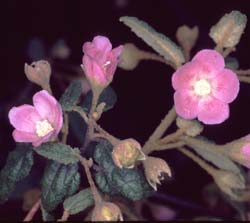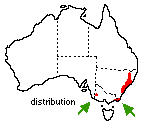Howittia trilocularis
 |
Blue Howittia
Howittia trilocularis F.Muell.
Howittia trilocularis, a monotypic genus, is native to the moist, well-drained gullies of coastal New South Wales and Victoria, where it has been known to reach a height of 3 m.
 It
is am member of the family Malvaceae and is similar to the genus Hibiscus,
differing only in the presence of a three-lobed stigma and three-celled seed
capsule, as well as having a smaller flower 25 mm in diameter.
It
is am member of the family Malvaceae and is similar to the genus Hibiscus,
differing only in the presence of a three-lobed stigma and three-celled seed
capsule, as well as having a smaller flower 25 mm in diameter.
The flowers, ranging in colour from lavender through to violet and deep mauve, are borne on long woolly stems emerging from the leaf axils.
The actual flower is held alone on a woolly peduncle about 3-4 cm in length. It has five petals and a prominent protruding stigma. The flowering period in Canberra extends from late spring through summer and the seed capsules which follow mature and open from December to February.
The interesting leaf form ranges from ovate cordate to broadly lanceolate depending on growing conditions. Lobed leaves may be found although the lanceolate form is predominant. The dark green upper surface of the leaves, indented by the obvious venation, makes a welcome change and is another of its notable features. On the under surface can be found brownish wool which usually extends along the petiole from the mid-rib and on to the stem itself.
Ease of propagation by seed or cutting is another reason why this delicate blooming shrub should be present in a large number of home gardens.
Seed can be sown in a light sandy soil with about one-third peat moss or other suitable friable material. This allows some moisture to be held in the mix as well as the sand, allowing excess moisture to drain away.
Germination should be in about five weeks and the seedlings can be pricked out into a similar soil mix containing a little extra humus when about 5 cm in height. Leave until a good root system has developed before planting out.
Cuttings should be taken in either late spring or autumn with best results coming from new tip growth about 10 cm long. A hormone powder will stimulate rooting but it is not necessary.
In about three months roots will have developed and the seedlings can be removed from the cutting mixture (sand/perlite/peat moss) into pots of a similar soil mixture to the seedling requirements. One method is to put the cuttings into a punnet of cutting mixture with a jar or plastic bag over the punnet to contain a higher humidity zone around the cuttings.
The site is important when planting out although H. trilocularis will stand a wide range of areas. Best areas are those which are well drained and partly shaded. It will grow in full sun and can be exposed to frosts, but tends to become hardened in appearance and foliage becomes more sparse. Roots should be kept cool by selecting a site beside a building or mulching the selected area.
Text by: ANBG staff, 1977
* RHS Colour Chart, 1966: petals, purple-violet group 80B paling on the outside
to 80C.
Name meaning: Howittia trilocularisHowittia named after Dr Godfrey Howitt (fl. 1855), a Melbourne physician interested in botany; trilocularis botanical Latin, locularis = having cavities, and tri = three, referring to the three-celled fruit. |
![An Australian Government Initiative [logo]](/images/austgovt_brown_90px.gif)

